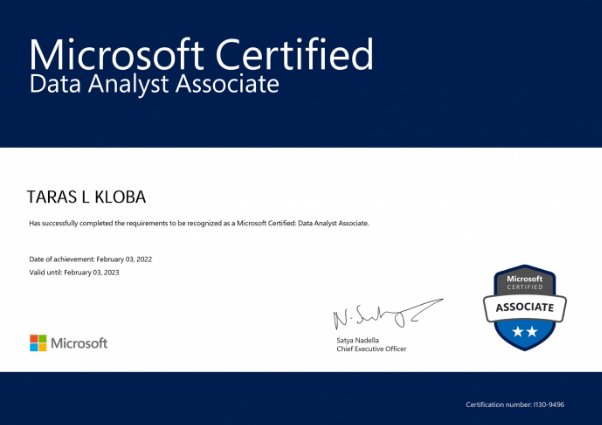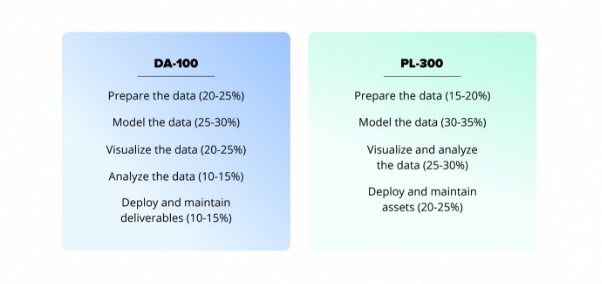How I became Microsoft Certified Data Analyst Associate: key tips
18 Feb 2022My name is Taras Kloba, and I am a Microsoft Certified Trainer with over 12 years of experience working with data. Recently, I’ve passed the DA-100: Analyzing Data with Microsoft Power BI exam and received a certificate confirming the title of Microsoft Data Analyst Associate. This certificate proves a certain level of competence of a data analysis specialist. Namely, a specialist of this level should understand data warehousing, data processing, visualization, preparation and transformation, design and construction of data models. After I shared the news about the certification on social media, many people started asking about the best approaches to exam preparation and the purpose of this certificate. That’s why I decided to share my experience.

WHY DID I DECIDE TO GET CERTIFIED?
There is an impressive report from Nigel Frank’s Career and Hiring Guide, according to which 48% of respondents say that their salary increased by an average of 19% after they received Microsoft Azure certification. Clearly, this can be a significant motivating factor for certification. What’s more, 55% of respondents say that this certification allowed them to test their skills in working with Azure products, and 49% of respondents add that the certificates became their advantage in the IT market.
For me, this is also a great way to evaluate my technical skills. In addition, I develop Upskilling programs at SoftServe and believe that it is unfair to force colleagues into such certification when you haven’t got it yourself yet. Lead by example. In addition, SoftServe covers most of the costs of professional certification by the company’s vendor partners, so why not take this opportunity? And for those who want to join SoftServe in the future, I’d like to add that our company is constantly monitoring specialists who’ve recently gotten certified and interviews many of them. So, the certification increases your chances of being hunted by a global IT company.
CHANGES IN EXAMS FOR MICROSOFT POWER BI DATA ANALYST ASSOCIATE
Currently, Microsoft is significantly changing its approach to certification. That is why there are new certifications for technical roles (for example, Data Analyst, Data Engineer, Data Scientist, etc.) instead of the technology certifications (Microsoft SQL Server, Microsoft Power BI). This change applies to the professional certification in question as well. So, starting from February 2022, one must pass the PL-300 exam (it used to be the DA-100 exam) to get the Microsoft Power BI Data Analyst Associate status. The new exam is barely different, except its focus switching to data modeling, deployment, and resource support.
Here is a short comparison:

Find more information about the DA-100 and PL-300 exams on the official Microsoft website.
It would be wrong to be called and certified as a Data Analyst if the exam only covered Microsoft Power BI. That’s why this exam also has questions about data modeling, relationships, cardinality, and dimensions, which are technology-agnostic. Therefore, your previous experience, including the one with other BI platforms, will allow you to answer the questions correctly.
WHAT DO YOU NEED TO KNOW ABOUT THE CERTIFICATION?
Most professional certifications (from Microsoft, Amazon, Google) are conducted on the Pearson VUE platform. You need to go to the Microsoft Learn website, click the Schedule exam button, follow the instructions, and plan the time and place of the professional certification.
There are two options: you can take the exam at home or at a certification center. I tried both. At home, be prepared to adhere to many restrictions. When I received Google Certified Professional Cloud Architect status, I could only have one monitor in the workplace—laptop or workstation. No one could enter the room. I had to put my phone down and switch it to airplane mode. I was even asked to remove the chain from my neck (maybe they thought it could be a listening device?). And when I got deep in thoughts and took my eyes off the screen, the administrator temporarily blocked my access and asked me to look only at the monitor.
And still, I wanted to take the DA-100 exam at home as well, but couldn’t do it for technical reasons. That’s why I registered for the exam in one of the SoftServe certification centers in Lviv. There were fewer restrictions—I was allowed to use a water cooler and a mini-whiteboard for notes. By the way, the last one helped me solve one of the tests. I had to transpose the table, and it was rather difficult for me to do in my head, but when I drew everything on the mini-board, the correct answer came almost immediately.
My exam consisted of 62 questions. Most of them were about Data Analytics, focusing on Power BI, 14 questions were based on case studies, and 6 were Yes/No questions. I had a total of 180 minutes, and I think that’s enough. To certify successfully, you need to score 700 points out of 1,000 possible. The results of Microsoft certifications come right away, so you don’t have to put your nerves to test as well waiting for several days or even weeks (like with other certifications, such as GCP). Your certificate will be valid for two years after you successfully pass the exam. Also, you can download it, together with the badge, from Microsoft Certification Dashboard in 24-48 hours.
The cost of the exam varies from country to country. In Ukraine, it costs 80 USD, while in the US it’s already 165 USD. However, note that students and those who lost their jobs through COVID-19 can get significant discounts.
HOW TO PREPARE FOR THE EXAM?
First of all, you need to ”motivate” yourself from the start not to postpone the exam. For this, I pay for it right away, add it to the calendar, and have a clear deadline. I don’t recommend taking more than two months to prepare because this time is usually more than enough.
To my mind, the best preparation is a constant practice in Power BI, modeling data warehouses, and their analysis. My acquaintance with Power BI began five years ago, when I was working on a research paper and looking for ways to visualize and present its results. Later, I had other pet projects where Power BI came in handy again. I also have over ten years of experience using other BI platforms (Fast Reports, SAP BusinessObjects, SQL Server Reporting Services, JasperReports, Tableau, Looker, Google Data Studio, and Amazon QuickSight), which has allowed me to understand many aspects of Power BI intuitively.
However, I haven’t started working with Power BI Service until recently. Preparing for the exam allowed me to learn a lot about Power BI functionality and organize my knowledge well. Even if you’ve been working with a product for many years, new features appear every month, and you can easily miss them. A structured and comprehensive approach to certification preparation helps you see and explore them. Namely, the features that I’ve learned this way are Decomposition Tree, Key Influencers visual, Row-level security, and Q&A.
It’s best to prepare comprehensively with the help of the curriculum on the Microsoft Learn platform. The modules there fully correspond to the exam program, and you have a lot of labs that allow you to gain additional practical knowledge.
Additionally, I recommend going through the list of topics provided below. If you feel that there are topics that you aren’t sure about or have gaps in, it’s a good idea to look for the corresponding information in the documentation.
Here are some more tips that may come in handy:
- Read the questions carefully. Sometimes, the questions may be constructed using the word NOT, but your brain, being put in a stressful situation, can miss this important point
- If you can’t come up with an answer even after reading the question several times, remember that you can mark it as a Review and come back to it later
- To answer some questions, you’ll need to get familiar with the proposed case studies. Take them seriously because the questions in this section are quite tricky, and you must read the conditions and limitations of the case studies carefully to answer them
I could have ended this piece here, but I also want to recommend these courses on Udemy if you prefer video format:
- DA-100, PL-300 certification Analyzing Data with MS Power BI - $ 15.99
- Microsoft Power BI Certification: DA-100, PL-300 Exam Prep - $ 15.99
What’s more, here are some YouTube channels that may help you with this:
For me, this certification turned out to be quite easy, and I spent no more than 20 hours on preparation (however, keep in mind that I have 10+ years of practical experience in the BI field).
Don’t stop after getting certified, keep maintaining your skills and gaining new knowledge.